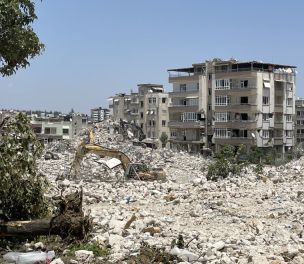MHP leader Devlet Bahçeli (l) and New Welfare leader Fatih Erbakan accompanied Erdoğan in Antep. (Photo: AA)
During his recent visits to Adıyaman, Maraş, Hatay, and Gaziantep over the weekend, President Recep Tayyip Erdoğan reaffirmed his commitment to expedite the reconstruction process in provinces affected by the February 6 earthquake. He promised to deliver new homes by October or November if he wins the upcoming presidential elections on May 28.
Emphasizing that the government is working at full speed, Erdoğan outlined their ambitious goal of constructing 650,000 new homes, with 319,000 expected to be completed within a year.
In the severely affected province of Maraş, he stressed the importance of achieving a high voter turnout, aiming to increase his support to 80%.
CLICK - Erdoğan secures strong victory in Turkey's earthquake-hit regions
Following the devastating tremors, President Erdoğan swiftly pledged to rebuild thousands of houses. Subsequently, on February 24, a presidential decree was issued to initiate construction in the affected urban areas.
However, critics, including the Union of Turkish Chambers of Architects and Engineers (TMMOB), cautioned against hasty construction due to ongoing aftershocks that could potentially undermine the structural integrity of the buildings. They advocated for ensuring decent living conditions for the victims in temporary settlements.
Furthermore, some detractors argue that the contracts for rapid housing projects in the quake-hit regions are awarded to business tycoons with close ties to the government.
The earthquakes
On February 6th, two earthquakes with a magnitude of 7.7 and 7.6 struck the southern province of Maraş in Turkey, causing devastation across 11 provinces in the south and southeast of the country and northern parts of Syria.
Over 50,000 people have been confirmed dead, and more than 227,000 buildings were destroyed or severely damaged, according to government figures.
The latest report from the United Nations shows that the situation in the earthquake-affected area remains dire, with ongoing challenges exacerbating the crisis. Heavy rainfall and aftershocks have continued to wreak havoc in the region, further hampering relief efforts.
As a result, approximately 1.6 million people are still living in temporary shelters or makeshift tents, with limited access to essential services and basic living conditions. Additionally, three million people have been forced to flee their homes due to the disaster.
(VK)






as.jpg)